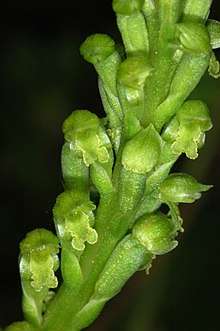Microtis arenaria
Microtis arenaria, commonly known as the notched onion orchid,[2] is a species of orchid endemic to south-eastern Australia. It has a single hollow, onion-like leaf and up to sixty scented, crowded yellowish-green flowers. It is widespread and common, growing in a wide variety of habitats.
| Notched onion orchid | |
|---|---|
 | |
| Microtis arenaria in the Mount Remarkable National Park | |
| Scientific classification | |
| Kingdom: | Plantae |
| Clade: | Tracheophytes |
| Clade: | Angiosperms |
| Clade: | Monocots |
| Order: | Asparagales |
| Family: | Orchidaceae |
| Subfamily: | Orchidoideae |
| Tribe: | Diurideae |
| Genus: | Microtis |
| Species: | M. angusii |
| Binomial name | |
| Microtis angusii | |
| Synonyms[1] | |
Description
Microtis arenaria is a terrestrial, perennial, deciduous, herb with an underground tuber and a single erect, smooth, tubular leaf 300–800 mm (10–30 in) long and 6–7 mm (0.2–0.3 in) wide. Between ten and sixty yellowish-green, fragrant flowers are crowded along a flowering stem 350–600 mm (10–20 in) tall. The flowers are 3–3.5 mm (0.12–0.14 in) long and 2–2.5 mm (0.08–0.1 in) wide. The dorsal sepal is egg-shaped, 2.5 mm (0.1 in) long and wide with its tip turned slightly upwards. The lateral sepals are 2.5 mm (0.1 in) long, about 1 mm (0.04 in) wide with their tips rolled under. The petals are lance-shaped but curved, about 2 mm (0.08 in) long, 1 mm (0.04 in) wide and are held under the dorsal sepal. The labellum curves downwards and is 3.5 mm (0.1 in) long, about 3 mm (0.1 in) wide with scalloped edges and a notch at the tip between two prominent lobes. There is an irregularly-shaped callus in the centre of the labellum. Flowering occurs from September to December.[2][3]
Taxonomy and naming
Microtis arenaria was first formally described in 1840 by John Lindley and the description was published in The Genera and Species of Orchidaceous Plants.[4][5] The specific epithet (arenaria) is a Latin word meaning "sandy".[6]
Distribution and habitat
The notched onion orchid is widespread and common in south-eastern New South Wales, throughout Victoria, Tasmania and south-eastern South Australia. It grows in a range of habitats from sandhills to rocky inland outcrops but is most common in coastal sand.[2][3][7]
References
- "Microtis arenaria". World Checklist of Selected Plant Families (WCSP). Royal Botanic Gardens, Kew.
- Jones, David L. (2006). A complete guide to native orchids of Australia including the island territories. Frenchs Forest, N.S.W.: New Holland. pp. 222–223. ISBN 1877069124.
- Jeanes, Jeff. "Microtis arenaria". Royal Botanic Gardens Victoria. Retrieved 18 February 2018.
- "Microtis arenaria". APNI. Retrieved 18 February 2018.
- Lindley, John (1840). The gnera and species of orchidaceous plants. London: Ridgways. p. 396. Retrieved 18 February 2018.
- Brown, Roland Wilbur (1956). The Composition of Scientific Words. Washington, D.C.: Smithsonian Institution Press. p. 100.
- Jones, David L. (1998). "Contributions to Tasmanian orchidology". Australian Orchid Research. 3: 11.
External links

